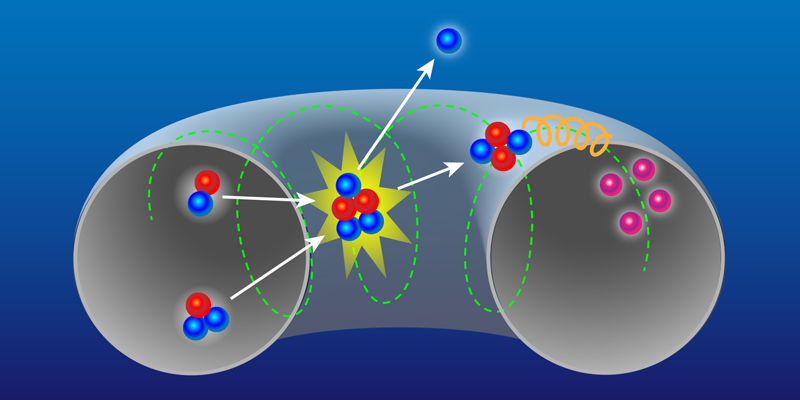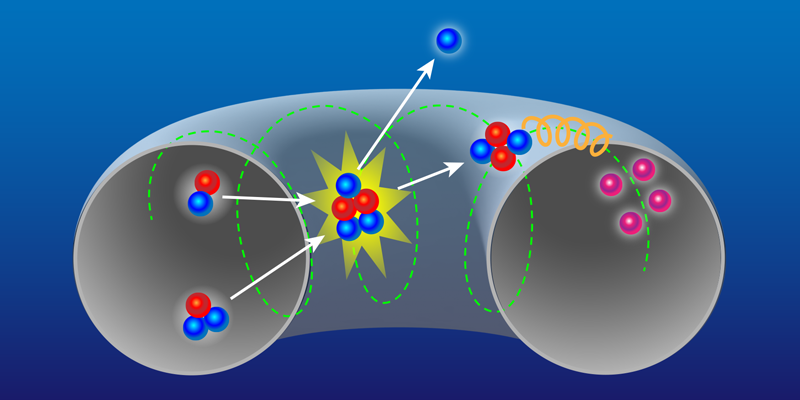Nuclear Fusion Heats Up
A fusion reactor would generate electricity using the energy released by nuclear-fusion reactions occurring in a plasma. A key step in the race toward realizing the dream of such a reactor is the creation of a burning plasma—one in which the fusion reactions themselves supply most of the heating needed to keep the plasma at fusion-relevant temperatures. This step has recently been demonstrated for inertially confined plasmas [1, 2] (see Research News: Ignition First in a Fusion Reaction) but has so far remained elusive for magnetically confined ones. This goal could now be within reach thanks to direct evidence for fusion-induced heating of electrons in magnetically confined plasmas obtained by Vasily Kiptily and colleagues at the UK-based Joint European Torus (JET) facility [3].
The fusion of two heavy hydrogen isotopes—deuterium (D) and tritium (T)—presents the most promising path to a fusion reactor, both because of the relative ease in getting these isotopes to fuse and because of the large amount of energy released in each reaction. When D and T fuse, an alpha particle (a helium-4 nucleus) and a neutron are generated, carrying the released energy in the form of kinetic energy. The goal of achieving energy production from controlled fusion on Earth relies on the created alpha particles remaining in the plasma and heating the fusion fuel to keep the reactions going, while the kinetic energy of neutrons escaping the plasma is converted to electrical energy.
In inertial confinement fusion, lasers compress a tiny pellet of DT fuel to high density and temperature, relying on the inertia of the assembled material to keep it together long enough for fusion reactions to propagate through the fuel. A reactor based on this approach would have to be pulsed, with fusion implosions repeating several times per second. Magnetic confinement fusion, by contrast, relies on keeping the hot fusing plasma sustainably contained by having the plasma ions and electrons spiral along magnetic-field lines—most popularly in a donut-shaped vessel called a tokamak. The tokamak is widely considered as a leading candidate for a fusion reactor, with large ongoing tokamak constructions including the multidecade international-collaboration project ITER [4] and the more recently conceived and heavily privately funded SPARC [5]. Demonstrating self-heating and burning-plasma physics in a tokamak is a key goal for fusion researchers.
The first attempts at realizing tokamak self-heating came at the Tokamak Fusion Test Reactor [6] and at the JET tokamak [7] when these two devices were first operated with DT fuel in the 1990s. However, the successes of those early experiments were questioned [8], making a less ambiguous demonstration of alpha heating (plasma heating induced by alpha particles) a primary goal of a 2021 DT campaign at JET. The new results from Kiptily and colleagues show that this goal was achieved (Fig. 1).
The researchers operated the JET tokamak using a DT plasma, or a comparable D-only plasma, and applied external heating in the form of an injected beam of neutral particles. They then compared the two plasmas in the period immediately after this heating had been switched off. They found that the temperature of electrons decreased in the D plasma but kept climbing in the DT plasma. This rise in electron temperature without external heating represents the first direct observation of alpha heating in a magnetically confined plasma. The comparison between otherwise-identical D and DT plasmas is a major strength of this work. Although the fusion products generated in a D plasma could, in principle, also heat the fuel, any such effect would be negligible because the fusion-reaction rate is 2 orders of magnitude lower than in the DT equivalent.
Kiptily and colleagues attribute the observed electron-heating boost to self-heating because the alpha particles would have transferred their energy primarily to electrons, not to ions, whereas the neutral-beam injection would have led to ion heating directly. The reason is that there is a critical energy for the particles inducing the heating below which the rate of energy given to ions exceeds that given to electrons and above which the opposite holds [9]. The neutral beams were injected below this critical energy, whereas the alpha particles were born well above this energy. Given the measured plasma conditions, confined alpha particles also should have remained above this critical energy for the duration of the observations.
Whereas the present work concerns electron heating, ultimately, controlled fusion relies on self-heating of the fuel ions. Kiptily and colleagues do not present ion-temperature measurements, but their modeling suggests that alpha heating of ions was insignificant in their experiments. JET is slated to shut down at the end of 2023. Although the direct demonstration of electron heating provides a first step toward magnetically confined burning plasmas, the next steps will be taken on future devices, including the aforementioned ITER and SPARC.
Experimentally, burning-plasma physics remains a mostly unexplored frontier. One question concerns the detailed dynamics underlying the alpha heating of ions. The alpha particles will, as discussed, impart energy primarily to electrons. However, previous work has reported evidence of alpha channeling—energy exchange of alpha particles and ions, mediated by plasma waves—and predictions of interplay with magnetohydrodynamic waves and turbulence that might lead to increased ion heating. Another question in magnetic confinement fusion is how relying on only alpha heating will impact the ability to regulate the plasma. Currently, heat load and instability growth are controlled by turning on and off external heating, but such control would not be available for a self-heating plasma. These questions and others will be key topics of investigation for tokamaks currently under construction.
The burning plasmas recently achieved in inertial confinement fusion have presented at least one big surprise: apparent evidence of unexpected (suprathermal) ion-velocity distributions [10]. Burning-plasma physics is an area of overlap between inertial and magnetic confinement fusion, where researchers working on the two concepts can learn from each other’s results as they each push the boundaries toward a future commercial fusion reactor.
References
- A. B. Zylstra et al., “Burning plasma achieved in inertial fusion,” Nature 601 (2022).
- H. Abu-Shawareb et al., “Lawson criterion for ignition exceeded in an inertial fusion experiment,” Phys. Rev. Lett. 129 (2022).
- V. G. Kiptily et al., “Evidence of electron heating by alpha particles in JET deuterium-tritium plasmas,” Phys. Rev. Lett. 131, 075101 (2023).
- K. Ikeda, “Progress in the ITER physics basis,” Nucl. Fusion 47 (2007).
- P. Rodriguez-Fernandez et al., “Overview of the SPARC physics basis towards the exploration of burning-plasma regimes in high-field, compact tokamaks,” Nucl. Fusion 62 (2022).
- G. Taylor et al., “Fusion heating in a deuterium-tritium tokamak plasma,” Phys. Rev. Lett. 76 (1996).
- P. R. Thomas et al., “Observation of alpha heating in JET DT plasmas,” Phys. Rev. Lett. 80 (1998).
- R. V. Budny, “Alpha heating and isotopic mass effects in JET plasmas with sawteeth,” Nucl. Fusion 56 (2016).
- T. H. Stix, “Heating of toroidal plasmas by neutral injection,” Plasma Phys. 14 (1972).
- E. P. Hartouni et al., “Evidence for suprathermal ion distribution in burning plasmas,” Nat. Phys. 19 (2022).





